- Home
- David R. George III
Star Trek: The Fall: Revelation and Dust Page 5
Star Trek: The Fall: Revelation and Dust Read online
Page 5
Kira regarded her friend, standing in mute devastation across the cabin from where his first wife had just perished. And then, with no observable transition, Benjamin crouched again beneath the fallen beam, looking down at the lifeless form of Jennifer. He immediately rushed backward again, as though retreating from a ticking bomb.
“What is the point of bringing me back again to this?” he yelled, not masking either his pain or his anger.
“We do not bring you here,” said Jake, no longer sitting on the bridge above the pond, but standing in the cabin aboard Saratoga, across from Benjamin. Beside him stood Jennifer, dressed as she had been in the park, and even as she lay dead on the deck.
“You bring us here,” she said.
“You exist here,” said the Bolian officer, whose name and position—Hranok Zar, tactical officer—arose in Kira’s mind, though she should not have known either piece of information. Zar spoke in a way that made it sound as though he believed his statement not merely accurate, but a truism.
“Then give me the power to lead you somewhere else,” Benjamin fired back, moving toward the trio. “Anywhere else.”
To Benjamin’s right, in front of a pillar of flame, Opaka spoke up. “We cannot give you what you deny yourself,” she said. “Look for solutions within, Commander.”
Benjamin stopped and looked at Opaka. Kira waited, wondering what the Prophets wanted of him—and what They wanted of her. Why are They showing all of this to me?
Benjamin looked down at his wife’s corpse, then back to Opaka. “I was ready to die with her,” he offered quietly.
“Die?” Zar asked, and then, almost predictably, added, “What is this?”
The living Jennifer Sisko stepped forward. “The termination of their linear existence,” she said. She walked over to Benjamin and regarded him with an expression that seemed born of both wonder and pity. She raised a hand to his cheek and gently pressed her fingers and palm against his face.
Weapons fire rocked the starship, and the living Jennifer looked down at the still body of Benjamin’s wife. “We’ve got to go now, sir,” called another version of Zar—not a Prophet, Kira understood, but a character replaying one of the Emissary’s memories.
Beside the body of Jennifer Sisko, Lieutenant Zar threw his hands beneath another iteration of Benjamin and hauled him backward. “We can’t just leave her here,” yelled Benjamin in his unfolding memory. His words devolved into agonized cries as Zar pulled him across the cabin and out into the corridor.
Benjamin watched himself as he had been on Saratoga during that battle against a Borg ship, then slowly turned back toward the Prophet animating the other version of Jennifer. “I never left this ship,” he told her, and Kira’s heart broke. She knew what it meant to live with death, with loss, holding on to the grief and anger and regret, not moving forward. During her life in the Resistance, she’d learned to channel her emotions, to funnel her rage at the occupiers of her world, the enslavers of her people. It had taken many more years than that, though, and a great deal of effort for her to fully deal with those emotions and put them to rest. After his tragic loss, Benjamin had gone on raising his son, but clearly, by the time he’d arrived in the Bajoran system, he still hadn’t understood and processed what he felt.
“You exist here,” the living Jennifer told him.
Benjamin’s facial muscles tensed. He stared back at the Prophet who wore the form of the woman he had loved and lost. “I . . . exist here,” he said, slowly and painfully admitting what he had obviously never confessed to himself.
After a moment, Benjamin made his way past Opaka, through the wrecked cabin, back to the pile of rubble, and kneeled beside his dead wife. The living Jennifer followed and sat down behind him. “I don’t know if you can understand,” he told the Prophet. “I see her like this.” He began to weep. “Every time I close my eyes. In the darkness . . . in the blink of an eye . . . I see her like this.”
“None of your past experiences helped prepare you for this consequence,” said the living Jennifer.
“And I have never figured out how to live without her,” Benjamin said.
“So you choose to exist here,” the living Jennifer said. “It is not linear.”
“No,” Benjamin said, his face contorted by misery. Tears spilled from his eyes. “It is not linear.” He began to sob uncontrollably. Kira’s temples throbbed, and her vision wavered as her own eyes filled. She lamented not only Benjamin’s loss, but his having to relive it so vividly.
Still crying, he looked over at Opaka. She peered back at him without saying anything, the wisdom in her countenance more than a passing re-creation of that possessed by the real Opaka. The former kai returned Benjamin’s look as though willing him to find his own answers.
Benjamin then gazed over at Jake, who nodded slowly in response. He too seemed to encourage the Emissary. The gesture seemed very much like a son telling a father that the time had come to move on, to return to living, even if that meant letting go of the son’s mother and the father’s wife—letting go of the painful memories of Jennifer, shedding the harrowing emotions still invested in her loss.
Still crying, Benjamin nodded back at Jake, indicating that he understood what next must happen. Benjamin physically deflated, falling on the deck a bit, but Kira also saw that, as traumatic as the replayed experience had been for him, the Prophets had still given him a gift: what They had done would allow Benjamin to confront the demons that haunted him so that he could finally move past them.
Kira watched him weep for a long time.
Three
Lieutenant Commander Jefferson Blackmer sat at the security console in the Hub. The panel, canted upward for better viewing, stretched in an arc before him, all of its control surfaces laid out within easy reach, with perfect visibility to all of its displays. Blackmer loved the reconfigurable design, which, after several months of trial and error, he’d finally arranged to his satisfaction, and which he called up for use every time he relieved his delta-shift subordinate.
The security chief also appreciated having a dedicated console in Deep Space 9’s operations center. On the old station, he’d been relegated to discharging his responsibilities from his office on the Promenade, a problematic situation when it came to dealing with issues affected by, or affecting, other departments and the chain of command. The new DS9 provided Blackmer with three permanent full-function control panels at which he and his staff could manage the starbase’s security needs: in the Hub, in the office adjoining the detention cells on the Plaza, and within the stockade complex. Of course, he could adapt any console on any deck for his use, but working in such circumstances could not compare to doing so in the Hub, alongside the rest of the command crew.
Blackmer swept his gaze across his readouts, verifying the integrity of DS9’s internal and external security. His console stood on the raised, outer ring of the operations center. To him, the Hub resembled a starship bridge that had been partially inverted. The primary workstations lined the periphery of the circular space, but marched along the inner edge of the ring rather than along the outer bulkhead. In that way, every major panel faced inward, toward the lower, central area called the Well, which housed a large, round situation table. Spacious and bright, the Hub also contrasted favorably with the confining, shadowy atmosphere of ops on the old station.
Blackmer saw a hologram projected above the sit table, depicting the starbase in real time. He saw the two ships currently docked at the station, both along the x-ring: the Cardassian vessel Trager and an unnamed Bajoran transport that bore the registry BMV-1. He also saw Rio Grande, a runabout on standard patrol, streak past on the outskirts of the three-dimensional image. Everything appeared relatively serene, but the security chief knew that the placid scene represented the calm before the storm. With just three days until DS9’s dedication and its evolution to full operation, the station would see a flurry of activity as several more heads of state descended upon it, and the bustle would only incre
ase as Starfleet’s newest starbase opened its docking bays to the entire Bajor Sector and beyond.
In the space over the sit table projection, a loop joining four separate but identical viewscreens hung suspended from the overhead, allowing visibility to one of the displays from anywhere in the Hub. An empty starscape showed at present, although the security chief easily picked out the green-white speck of Bajor in the black depths of space. Above, a circular port crowned the Hub.
The turbolift doors to Blackmer’s left whispered open. A quartet of lifts served the Hub, discharging into the operations center at each compass point, all of them carried there via an arc of the starbase’s vertical rings. Between each pair stood another door, collectively allowing access to the captain’s office, a transporter platform, a conference room, and a refresher facility. Various supplemental panels lined the outer bulkhead between the doors, crewed by supernumerary personnel.
Blackmer glanced over to see Captain Ro enter. Rather than head for the command chair—which sat to her left on the outer ring, across from the doors to her office—she paced directly forward and descended the three steps to the inner deck. She did not take one of the seats at the sit table, but stood and studied the holographic representation of the starbase. Ro then peered up at one of the view-screens overhead. “Where are we at, Desca?” she asked the first officer, who sat down at his position in the chair beside the captain’s.
Before Colonel Cenn could respond, all the displays on Blackmer’s console flashed calls for attention. At the same time, the red alert klaxon began to clamor. Messages and sensor measurements filled the central display on the security panel, while an adjoining screen showed an exterior view: a wavering field of stars, as though seen through a pool of choppy water. “Vessel decloaking,” he announced, interpreting all of the information presented to him before reading off the numbers posted on his console. “Bearing: thirty-seven degrees, mark eighty-one. Distance: one point eight million kilometers. Velocity: one-quarter impulse.” Despite the circumstances and the passage of two years’ time, Blackmer experienced déjà vu; he remembered all too well—he knew that all the survivors did—the starships that had decloaked in the Denorios Belt and opened fire on the old Deep Space 9 and its support vessels: first a Romulan warbird, followed by a Tzenkethi marauder, and finally a Breen battle cruiser. The result had been more than a thousand Federation dead and a demolished space station. For that reason, a tachyon detection grid had been erected about the new DS9, far enough away to allow the starbase crew time to react should it uncover the passage of a hidden vessel. The intruding ship decloaked outside that network.
From the tactical console, which abutted Blackmer’s to the right, Zivan Slaine spoke up. “Shields automatically raised,” she said. “Phasers have been brought online, quantum torpedoes are loading.”
Over the past several months, Captain Ro and her senior staff had debated the efficacy of enabling automated responses to potential threats. Deep Space 9 would occupy a major nexus of travel and trade routes in the sector, hosting an ever-changing roster of vessels and crews, meaning that red alerts could end up squalling through the station every five minutes. Because of DS9’s large number of residents and its sizable transient population, though, the captain and her entire crew felt more than ever the solemn obligation of safeguarding all those lives as best they could. Adding in the strategic importance of the starbase, as well as the harsh reality of its predecessor’s demise, and Captain Ro had chosen to err on the side of caution.
Chief Engineer Miles O’Brien, who had helped design and construct the new station, had worked with the security and tactical staffs to calibrate the automatic defenses. The captain and her command crew retained full control over the starbase’s shield and weapon systems, but the few seconds—or even fractions of seconds—saved by allowing the computer to initially react to specific sensor readings could make the difference in any attack on the station. Thinking of O’Brien, Blackmer glanced to his right, past the steps on the other side of Dalin Slaine, to where the chief crewed one of the Hub’s two engineering consoles. Ensign Amélie d’Arnaud sat beside him at the second.
Looking back at the sit table, Blackmer saw that the hologram of DS9 had vanished, replaced by the volume of shimmering space. “Get me an identification,” Ro said, “and open hailing frequencies.”
Directly across the Hub from Blackmer, Lieutenant Ren Kalanent Viss crewed the communications console. “Hailing frequencies,” she said, the helmet of her body-hugging environmental suit translating the aquatic clicks and chirps of her native Alonis language into passably feminine Federation Standard.
On one of Blackmer’s displays, the fluctuating image resolved into the recognizable form of a starship. Essentially wedge shaped, its hull a collection of straight lines and angles, the vessel carried its warp engines in a pair of equally sharp-edged nacelles. The ship-recognition routine immediately posted a label below it. Slaine announced the class and type of starship from her console, which had clearly provided her the same information. Blackmer and the dalin understood the overlap of their two positions—security and tactical—and they had developed an excellent working rapport that allowed them to function together efficiently. “Emerald-class Tholian juggernaut,” Slaine said. Blackmer saw that a holographic view of the massive vessel had appeared above the sit table. The ring of displays depending from the overhead also showed the encroaching Tholian ship.
“There’s no response to our hails,” said Viss.
“They’re running with weapons hot and shields raised,” Slaine said.
Blackmer quickly surveyed his console. He looked for any red or yellow indicators that would signal either a gap in the starbase’s internal security grid or some other possible threat. He had not forgotten that the destruction of the old station two years earlier had been accomplished not just by the attack of the three Typhon Pact vessels, but also by way of explosive devices planted on DS9 itself.
The security panel showed green.
“Open a channel on the standard Tholian frequency,” said Ro.
“I have a channel open for you, Captain,” Viss said, so quickly that she must have anticipated the order.
“Tholian vessel, this is Captain Ro Laren of starbase Deep Space 9.” Ro circled the sit table and mounted the steps closest to the command chair. On the outer ring, she sat down and focused on the overhead display facing her. “Your presence in this system is a violation of sovereign Federation territory and could be considered an act of war. If you do not deactivate your weapons and lower your shields at once, we will have no choice but to open fire on you.”
After a beat, Viss said, “Still no response.”
“They are responding,” Slaine said. “They’ve increased speed to full impulse and are heading directly for the station.”
“Fire phasers, two banks,” Ro ordered without hesitation. “Target their forward shields.”
Slaine’s hands darted across the tactical console, and Blackmer heard the auditory signals—like the squawks of a hydraulic pump, he’d always thought—that accompanied the actual triggering of the weapons. On his own panel, the security chief watched on a display as the red-tinged golden streaks found their mark. “Direct hits,” Slaine said. “They’re still coming. No change in course.”
Blackmer saw a pair of energy spikes on the Tholian interloper. “They’re returning fire,” he said. On one of his screens, twin lightning-white beams leaped from the bow of the juggernaut. An instant later, Blackmer’s panel erupted in a profusion of data, detailing the phaser strikes on Deep Space 9. “We’ve taken direct hits on the northwest quadrant, near the y-ring,” he reported. “Shields down to ninety-three percent there.” After a twenty-year career in Starfleet, Blackmer felt peculiar reading and repeating information about taking fire without actually hearing the punch of weapons against the station, without sensing the resultant vibrations through the deck, without the inertial dampers destabilizing and allowing the entire structure t
o quake.
“They’re firing again,” Slaine said.
“Fire phasers, all applicable banks. Concentrate on their forward shields,” Ro said. “Launch quantum torpedoes, full spread.”
“Firing phasers and torpedoes,” Slaine said. Again Blackmer heard the feedback of the weapon systems as Deep Space 9 unleashed its considerable armaments. He peered down to the sit table to see the Tholian ship continue toward the station, firing its own lethal beams. Blackmer watched DS9’s phaser bolts streak into the juggernaut, pounding into its forward shields and causing them to flare brightly. When a quantum torpedo exploded on impact, a brilliant blue flash encompassed the entire vessel for a few seconds, but still the juggernaut discharged its weapons at DS9.
“More strikes on the northwest quadrant of the station,” Blackmer said. “Shields down to ninety-one percent . . . down to eighty-seven percent.”
“Continuous fire,” Ro ordered. “I want that ship turned away.” Blackmer knew that the captain would first choose to end the confrontation before it escalated, but if she could not avoid a prolonged battle, she would do what she had to do in order to protect the people aboard DS9.
“They’re beginning evasive maneuvers,” Slaine said, even as Blackmer saw on one of his readouts that the Tholian vessel had deviated from its straight-line path. The juggernaut made a series of rapid course changes, effectively dodging and then outrunning most of the quantum torpedoes, though not all of them: two more crashed into the shields protecting it, and great jags of energy twisted across its hull. Though under assault, the ship still fired its phasers.

 Serpents Among the Ruins
Serpents Among the Ruins The Fire and the Rose
The Fire and the Rose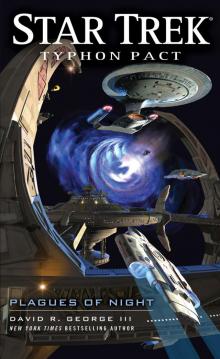 Star Trek: Typhon Pact 06: Plagues of Night
Star Trek: Typhon Pact 06: Plagues of Night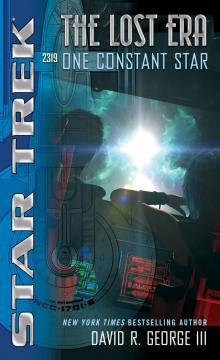 Star Trek: The Lost Era - 08 - 2319 - One Constant Star
Star Trek: The Lost Era - 08 - 2319 - One Constant Star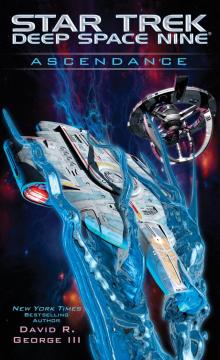 Star Trek: Deep Space Nine: Ascendance
Star Trek: Deep Space Nine: Ascendance Star Trek: TOS: Allegiance in Exile
Star Trek: TOS: Allegiance in Exile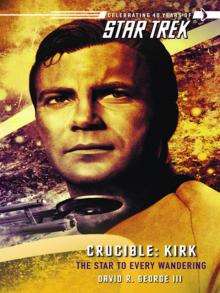 Crucible: Kirk
Crucible: Kirk Crucible: McCoy
Crucible: McCoy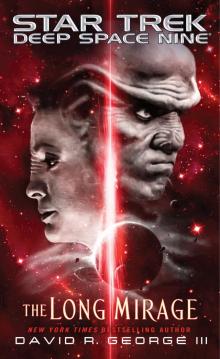 The Long Mirage
The Long Mirage Original Sin
Original Sin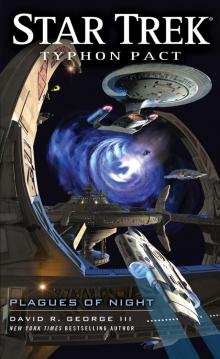 Star Trek: Typhon Pact: Plagues of Night
Star Trek: Typhon Pact: Plagues of Night Allegiance in Exile
Allegiance in Exile Sacraments of Fire
Sacraments of Fire Star Trek: Typhon Pact: Rough Beasts of Empire
Star Trek: Typhon Pact: Rough Beasts of Empire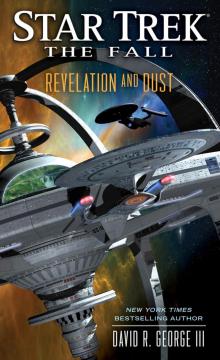 Star Trek: The Fall: Revelation and Dust
Star Trek: The Fall: Revelation and Dust